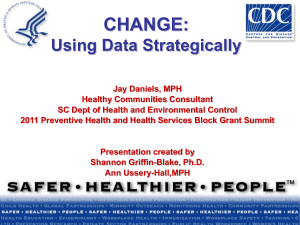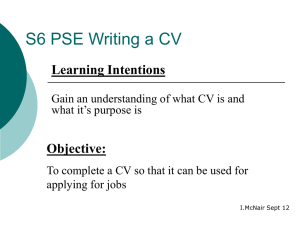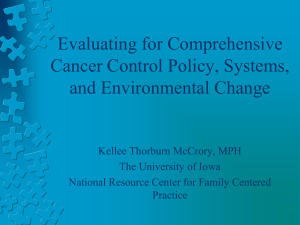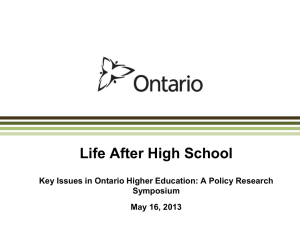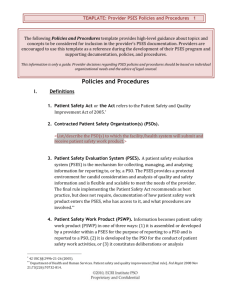Casting the Safety Net - Indiana Association for Healthcare Quality
advertisement
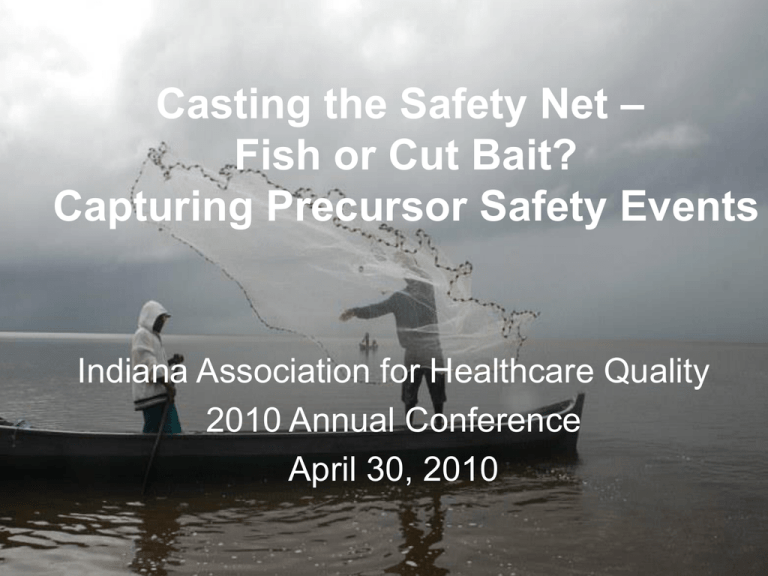
Casting the Safety Net – Fish or Cut Bait? Capturing Precursor Safety Events Indiana Association for Healthcare Quality 2010 Annual Conference April 30, 2010 Martha Boutin White, RN, BSN, MBA, Patient Safety Officer Memorial University Medical Center Savannah, GA Sherry L. Sweek, RHIA, CPHQ, CPMSM, Director of Quality Improvement Southeast Georgia Health System Brunswick, GA Objectives • Define Precursor Safety Events including errors of omission • Explain leverage points introduced to increase reporting and decrease errors • Share results and data analysis • Review lessons learned • Discuss next steps and recommendations Overview • • • • • • • Memorial’s safety journey 2008 Safety refocus Precursor safety events project How we got started Problems we encountered Current safety performance Next steps Memorial University Medical Center • Two-state healthcare organization servicing a 35-county area in southeast Georgia and southern South Carolina • Four-year medical school on campus affiliated with Mercer University School of Medicine • 530-bed tertiary hospital with Core Services: – – – – – – Level 1 Trauma Center Level 3 Neonatal Intensive Care Nursery Heart & Vascular Institute Curtis & Elizabeth Anderson Cancer Institute George & Marie Backus Children’s Hospital Rehabilitation Institute Off Course: An Alarming Trend in 2002 Overall (Near Miss + Sentinel Event)Trend Actual # of Events Best-fit Trendline 1998 1999 2000 2001 2002 2003 2004 Gaining Direction in Our Safety Journey • Conducted Mandatory Error Prevention Training (Team Members, Team Leaders and Physicians) • Enhanced Analysis of Events (Root Cause / Common Cause) • Established and Enforced “RED Rules” for Operating Room, Invasive Procedures, and overall Hospital Global “RED Rules” • Implemented Incident Scoring System (Compliance & Patient Outcome) • Incorporated Increased Reporting Metric (ROSI) in Team Leader Bonus Structure • Created Safety Coach Program and Dedicated FTE Positions We Thought We Had The Right Course Straying Off Course: 2006-2007 • Dealt with OIG Investigation for Alleged Stark Violations and 22 surveys in an 18 month time period • Observed 31% Decreased Incident Reporting • Discounted Increased Sentinel Events Due to Joint Commission Definition Changes • Failed to Recognize System Wide Issues and Implement Changes • Experienced Instability with Loss of Patient Safety Officer, COO, CNO, CFO, Director of Quality, VP of Quality and Patient Safety • Moved Away from Safety to Financial Situations by All Leaders • Not Cognizant of the Impact of Financial Woes on Safety MUMC Organizational Complacency Memorial Health SSE Rate 2002 to January 2008 Create a Safe Day Stage 5: Collapse SSE Rate Stage 4: Denial Stage 3: Blindness Stage 1:Good Operations Stage 2: Self Satisfaction Jan 02 May 02 Sep 02 Jan 03 May 03 Sep 03 Jan 04 May 04 Sep 04 Jan 05 May 05 Sep 05 Jan 06 May 06 Sep 06 Jan 07 May07 Sep 07 Jan 08 When Did We Fish? Dec 2007 Nov 2007 Oct 2007 Sep 2007 Aug 2007 Jul 2007 Jun 2007 May 2007 Apr 2007 Mar 2007 Feb 2007 Jan 2007 Dec 2006 Nov 2006 Oct 2006 Sep 2006 Aug 2006 Jul 2006 Jun 2006 May 2006 Apr 2006 Mar 2006 Feb 2006 Jan 2006 Dec 2005 Nov 2005 Oct 2005 Sep 2005 Aug 2005 Jul 2005 Jun 2005 May 2005 Apr 2005 0.90 Mar 2005 Feb 2005 Jan 2005 SSE Rate 1.00 Serious Safety Event Rate (SSER) for MUMC 2005 - Present per adjusted 10,000 patient days Serious Safety Events Serious Safety Event Rate for MUMC 0.80 0.70 0.60 0.50 0.40 0.30 0.20 0.10 0.00 Total Time to Complete a Root Cause Analysis • • • • • • • • • • • • Determination of SSE – 6–8 hours (x2) Communicating to stakeholders - 6 Charter – 1 hour Interviews – 1 hour each (x10x3) Swiss Cheese diagram – 1 hours Task Analysis – 3 hours Event Time Line – 2 hours (x2) Team Meetings – 2.5 hours each (x8x3) Report Completion – 2 hours Pre-report with Champion – 1 hour (x3) Presentation of Report – 1.5 hours (x4) Coding the event in database – 1 hour Total: 133 hours/month “We’re gonna know all there is to know about the PSE business” SEC Serious Safety Event Variation in standard of care Reaches the patient Death or major harm Cause Analysis Level: RCA Precursor Safety Event Variation in standard of care Reaches the patient Minimal or no harm Cause Analysis Level: ACA Serious Safety Events Precursor Safety Events Near Miss Variation in standard of care Does not reach the patient Cause Analysis Level: Trend, ACA Near Miss SM Safety Event Classification What is a Precursor Safety Event? • A precursor safety event is a variation in care that reaches the patient but does not cause permanent harm • • • • • • • • • • • • Delay in treatment Failure to recognize Improper Pt ID Inadequate check Inadequate handoff Inadequate monitoring Missed medication Missed treatment Omitted Action Wrong dose Wrong medication given Wrong treatment Redirecting the Focus to Prevention Nurse skips chart check Pharmacist enters wrong dose Pharmacy Tech fills order PSE SSE Physician writes ambiguous order NM NM NM Barriers to Harm Nurse administers 10X dose (medication overdose) Did We Have the Right Equipment? • License – Approval of Quality & Patient Safety Committee and Board of Directors to fish for PSEs • Net – Decree to increasing the number of incident reports became a strategic objective • Bait – Rewards for Safety Saves • Catch – Precursor Safety Events with coded information to drive improvement We Bought a Trawler...on Credit We Pulled Up Full Nets • 2009: 8,509 incidents, 2 Serious Safety Events – 709 incidents per month – 210 incidents per month visitor issues, workers comp or physician complaints – 144 incidents per month near misses – 355 PSEs per month • Everyone gets to eat…. Beware of Shifting Tides • Fishy Headlines – Paradigm Shift Required – Risk Management Shares Information and Promotes Transparency – No Compass on How to Navigate – Internal Sonar Better Than Nothing Risk Throws in a Flotation Device • Began Weekly Meeting with Risk – Review Precursor Safety Events – Verify Profession Involved – Define Inappropriate Act – Determine Apparent Cause Reports – Code Completed A/C reports – Review Safety Saves for PSEs Back on Dry Land… • Assign Apparent Cause Reports in Safety Database • Have Management Engineers Customize Database to House PSE information • Compile Safety Saves and Produce Certificates What’s Our Catch? Is It a Keeper? • WHEN I HAD FINISHED, I BROUGHT pt. N WAS NO LONGER WITH PT AND PT WAS NOT MONITORED. PT INITIALLY CAME TO ER FOR TRAUMA TO FACE/HEAD FROM FALL. PT WAS NOT AWAKE, OR COMMUNICATIVE WITH ME WHEN I BROUGHT HER TO THE SCANNER. I WAS ABOUT TO GET ASSISTANCE WITH MOVING THE PT WHEN SHE coded We Fish, They Feast • Generated Department Specific PSE Report • Included PSE Reports to Senior Leadership Rounds • Send PSE Reports to Managers, Directors and Safety Coaches • Modified PSE Report Format to Incorporate Voice of Customer Man Overboard!!! • Hard to Stay the Course When Everyone Wants to Change Direction • Teach Them to Fish, Teach Them to Fish, Teach Them to Fish • Safety Drills – Swiss Cheese of Errors – Reinforce Error Prevention Techniques – Required Actions from Senior Leadership, Directors, Managers I Caught a Fish This BIG… • Added PSE to Monthly Dashboard • Established Procedure for Accountability for Apparent Causes Completion • Determined Frequency of PSE Report to Quality Oversight Committee and Board of Directors • Conducted and Presented Common Cause Analysis Based on PSE Data My Fish is Bigger Than That • Safety Rounding Tool Modified Each Month Based on Data from PSEs – STAR (Stop, think, act, review) – Safety Huddles – Patient Identification • Pre Rounding Huddle for Unit Specific Trend or Unresolved Issues • Behavior Based Monitoring Compliance Included on Report and in Dashboard We Confirm Tears in The Nets Looking First for Tears in The Net • Included data from October 2008 through May 2009 • Data used to generate reports for Patient Safety Rounds • 734 Precursor Safety Events – 869 Inappropriate Acts – Majority of Inappropriate Acts are committed by “Sharp End” care givers • All PSE’s coded based on event description and additional investigation emphasizing coding data from: – Apparent Cause Reports – Level 1 or Level 2 PSEs (temporary or minor harm) • 70% of PSEs only partially coded due to incomplete information % of PSEs Related to Medical Errors 100% % of Errors 80% 62.50% 60% 45.90% 40.32% 40% 37.50% 36.47% 27.40% 22.43% 42.68% 33.33% 34.12% 18.75% 20% 0% Oct-08 Nov-08 Dec-08 Jan-09 Feb-09 Mar-09 Apr-09 May-09 Jun-09 Jul-09 Aug-09 Month Comparison of Medication Errors to Medication Safety Saves Errors Safety Saves 40 20 35 18 Data & A/C # of Errors 30 16 Approval for 6 mth study 14 PSE Report & Rewards 25 MAXPI 20 Saves & MAX Blitz 12 10 8 15 6 10 4 5 2 0 0 Oct-08 Nov-08 Dec-08 Jan-09 Feb-09 Mar-09 Month Apr-09 May-09 Jun-09 Jul-09 Aug-09 # of Safety Saves Mine Data A/C reports “PSEs are like a box of chocolates. You never know what you’re gonna get….” The Radar Suggests… • Sharp End Employees are Identified Most Often in Committing Inappropriate Acts – RNs, Pharmacists and Physicians • Common Threads Among all Professional groups – S.T.A.R. (Stop, Think, Act, and Review) – Rule Based Errors (Patient ID Error) • Limitations of The Data – Self-reported – Incomplete Data – Some Areas Still Perceive Reporting as Punitive EPTs All Professional Groups 400 350 300 250 200 150 100 50 0 S.T.A.R. - Stop, Check Each Other Think, Act, Review STOP when Unsure Adhere to Red Rules and policies Use SBAR, Ask Two Clarifying Coach Each Other SHARED Questions using "ARCC" Communication Methods Read Back and Verify Inappropriate Acts 140 120 100 80 60 40 20 0 Oct-08 Nov-08 Dec-08 Jan-09 Feb-09 Mar-09 Apr-09 May-09 Inappropriate Acts if S.T.A.R. Utilized 140 120 100 80 60 40 20 0 Oct-08 Nov-08 Dec-08 Jan-09 Feb-09 Mar-09 Apr-09 May-09 STAR as an Effective Error Prevention Tool – High Risk Areas Unit Inappro. Acts S.T.A.R. % of PSE's that could be prevented using S.T.A.R. Pharmacy ED NICN PEDS 67 44 39 32 43 15 21 15 64.2% 34.1% 53.8% 46.9% L&D OR NICU 27 19 6 4 12 2 14.8% 63.1% 33.3% TOTAL 234 112 47.9% •Above represent the units that have most frequent rounds •L&D EPT Stop When Unsure could have prevented 9 additional PSE’s Mending the Nets Charting the Course • Formed Two Ad-Hoc Teams on: – Integrating S.T.A.R. into Patient Safety Practice – Maximizing Report Quality in MAXPI • Team Initiatives Included on Top Ten List • Team Skippers were CNO and CFO • Development Center – Team Facilitation • Team Recommendation to Quality Oversight Committee with Implementation Plan Stay Within the Bouys • Added Precursor Safety Events Goals to Safety Improvement Plan • Included PSE Metrics on Monthly Dashboard • Reported PSE Trends Quarterly to Quality Oversight Committee and Board • Conducted annual PSE Common Cause Analysis 2009 Common Cause Navigation • 1102 Precursor Safety Events – 1310 Inappropriate Acts – 17.5% of PSEs with Temporary or Minor Harm – Results Mirror Common Cause from August 2009 – Five Straight Months with 100% of Apparent Cause Reports Completed in Two Weeks – 35%-45% of Inappropriate Acts are with Medication Nutrition Process – 50% of Inappropriate Acts could have been Prevented by Using STAR Precursor Safety Event Severity % of PSE's rated a 1 or 2 (minimal or moderate temporary harm) 40.0% 35.0% % 1 or 2 PSE Linear (% 1 or 2 PSE) 30.0% 25.0% 20.0% 15.0% 10.0% 5.0% 0.0% Oct-08 Nov-08 Dec-08 Jan-09 Feb-09 Mar-09 Apr-09 May-09 Jun-09 Jul-09 Aug-09 Sep-09 Oct-09 Nov-09 Dec-09 PSE Error Categories Inapp. Acts Knowledge Based Rule Based 77, 7% 39, 4% 976, 89% Skill Based PSE Professional Group Inappropriate Acts by Profession 900 800 786 700 600 500 400 300 200 96 95 100 71 55 36 31 30 25 28 15 Support Misc Clinical Therapy PCT Tech - Rad NonClinical 0 RN Pharmacist MD Tech - Lab HUC PSE Error Prevention Techniques EPTs All Professional Groups 600 500 400 300 200 100 0 S.T.A.R. - Stop, Check Each Other Think, Act, Review STOP when Unsure Adhere to Red Rules and policies Use SBAR, SHARED Communication Methods Ask Two Clarifying Coach Each Other Questions using "ARCC" Nearly 50% of all inappropriate acts could have been prevented utilizing S.T.A.R. Read Back and Verify S.T.A.R - RN Key Processes - RN 400 350 300 250 200 150 100 50 0 Medication and Nutrition Process Coordinating Care Patient Monitoring and Assessment Speciman Management Admission Transfer Discharge Invasive Procedure Utilizing STAR effectively could reduce 40% of inappropriate acts related to the medication and nutrition process. S.T.A.R - Pharmacy Key Processes - Pharmacy 90 80 70 60 50 40 30 20 10 0 Medication and Nutrition Process Coordinating Care Utilizing STAR effectively could reduce 68% of inappropriate acts related to the medication process. S.T.A.R – M.D.’s Key Processes - MD 35 30 25 20 15 10 5 0 Coordinating Care Medication and Nutrition Process Invasive Procedure Admission Transfer Discharge Patient Monitoring and Assessment Utilizing STAR could reduce 29% of inappropriate acts. 9 of 33 Coordinating Care issues had to do with adhering to red rules. Casting the Safety Net • Obtaining Right Incident Information Up Front a Challenge • Identifying PSEs Easier Said than Done • Moving Between Risk & Quality Databases Cumbersome • Preparing Leadership for the Number of PSEs is Important • Taking Action on PSE Data is Key to Making Gains on Patient Safety Our Goal: Catch Error Before Patient Harm • Let the data drive the improvements • Apply concerted and focused effort • Continue to raise the bar Human Error Serious Safety Event Are We Catching Any Fish? 2007 2008 2009 AHRQ Patient Safety Score SSEs Not Collected 12 69% 77% 4 2 SSE Rate per 10,000 Adj. Patient Days Avg. Days Between Events PSEs 0.45 0.18 0.08 37 73 182 Not Collected Not Collected 1102 0.60 3 0.50 # SSE 0.80 2005 2005 2005 2005 2005 2005 2005 2005 2005 2005 2005 2005 2006 2006 2006 2006 2006 2006 2006 2006 2006 2006 2006 2006 2007 2007 2007 2007 2007 2007 2007 2007 2007 2007 2007 2007 2008 2008 2008 2008 2008 2008 2008 2008 2008 2008 2008 2008 2009 2009 2009 2009 2009 2009 2009 2009 2009 2009 2009 2009 0.90 Jan Feb Mar Apr May Jun Jul Aug Sep Oct Nov Dec Jan Feb Mar Apr May Jun Jul Aug Sep Oct Nov Dec Jan Feb Mar Apr May Jun Jul Aug Sep Oct Nov Dec Jan Feb Mar Apr May Jun Jul Aug Sep Oct Nov Dec Jan Feb Mar Apr May Jun Jul Aug Sep Oct Nov Dec SSE Rate 1.00 Serious Safety Event Rate (SSER) for MUMC 2005 - Present per adjusted 10,000 patient days • Insert the chart 0.20 0.00 5 Serious Safety Events Serious Safety Event Rate for MUMC 4 0.70 0.40 2 0.30 1 0.10 0 2010 Safety Goal Event Free Calendar 250 Days Navigating in New Waters… • Completed a Business Case for Safety – 68% decrease in cost of completing root cause investigations and savings of over $100,000 – Costs associated with payouts and write-offs decreased by 90% and savings of over $400,000 • More staff time to fish because we were not spending time and effort on reactive steps for safety • Managers able to spend time on Precursor Safety Events “That’s all I have to say about that…” Questions? Contact Information Sherry Sweek Southeast Georgia Health System 2450 Parkwood Drive Brunswick, GA 31520 912.466.2124 ssweek@sghs.org Martha White Memorial University Medical Center 4750 Waters Ave, Suite 451 Savannah, GA 31404 912.350.7569 whitema2@memorialhealth.com
